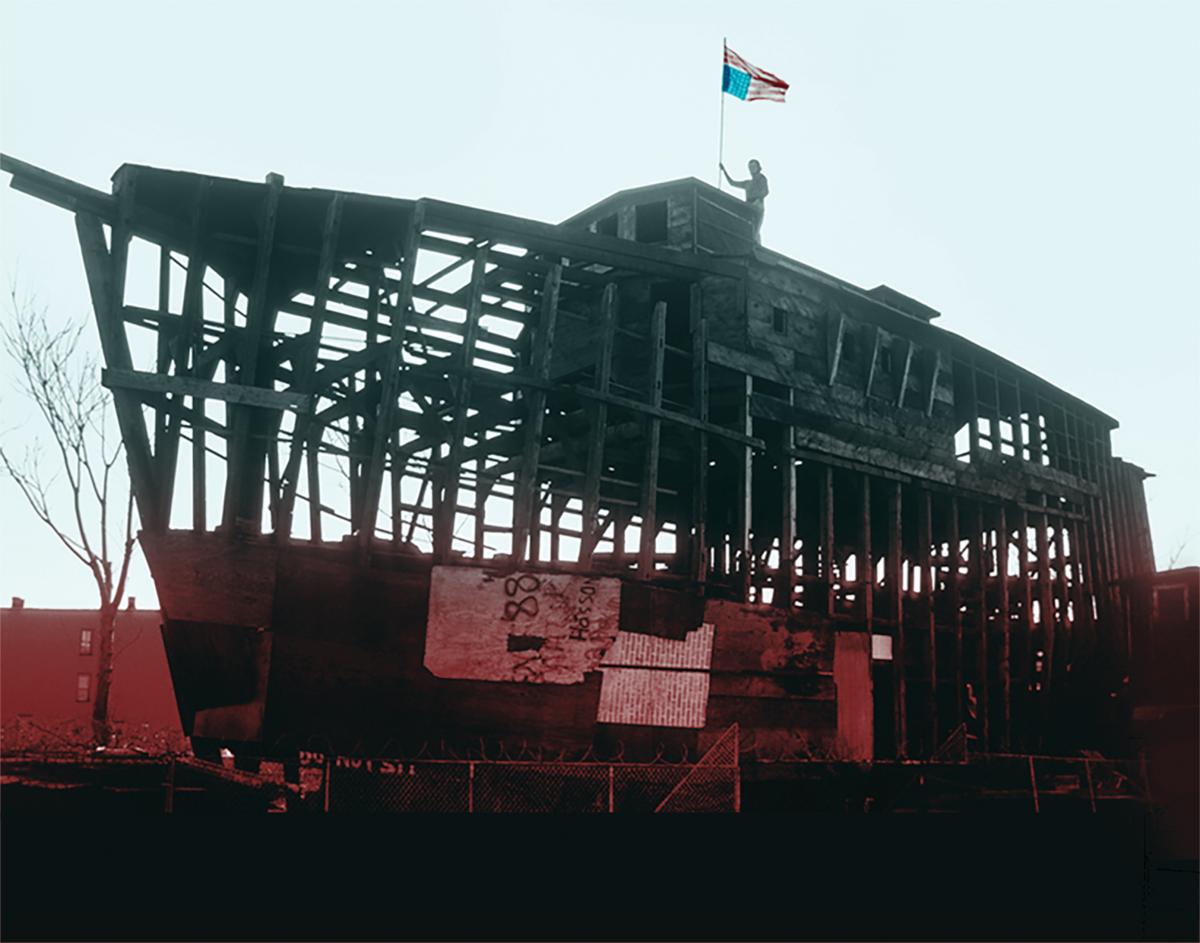By 1988, when she was ordered to destroy it, Kea Tawana’s ark was known around the world. But on August 8, 1982, when she began construction, “Captain K.T.” was all alone. “No seas, weather fair, the keel was laid on the ways at 11:30 hours by myself,” she wrote in her captain’s log. “It is six by eight inches and assembled will be 60 feet long. . . . We dedicated the ship to the Glory of God, taking note of how perilous the times now are.”
There were no seas because Tawana was building her new ark on a vacant lot in the middle of Newark, New Jersey. The three-story-tall ship was one of the few things going up in the city’s Central Ward, which, after the uprisings and political unrest of 1967, had been left to burn and collapse. Tawana built the ark from lumber and machinery she salvaged from abandoned buildings and demolition jobs. A “self-taught engineer,” Tawana based the ark’s design on her library of discarded nautical manuals, which she kept in the split-level house she built on the back of a flatbed truck. To someone who’d been on her own and on the move since she was twelve years old, an ark made all the sense in the world. How did the world see it?
The story of Kea Tawana and her ark is riddled with gaps and varies with the era and the storyteller. Tawana’s obituary in 2016 said she was born on an Indian reservation (possibly Hopi) in 1940. To reporters covering the ark story, though, she said she had been born in Japan, that she’d lost her mother in the firebombing of Tokyo, fled to the U.S., and lost her American father to a shooting in a refugee camp in San Diego. At twelve, she said, she jumped a train and fled an orphanage in Flagstaff. Whatever the details, she seems to have moved around the country until the mid 1950s, when she made Newark the center of her tristate wanderings. And though she identified as a woman, Tawana didn’t mind, she said, when reporters described her as male; she explained that she’d revealed her true gender only in 1985, after decades of passing as a man. It all seemed as plausible as the ark itself.
For the first few years, the ark was the oddball obsession of the local eccentric, but also a refuge and a symbol of hope in a neighborhood that had been abandoned by the powers that be. When those powers took notice, the unfinished ark became an eyesore and an obstacle to redevelopment. It also became a media sensation, a photogenic shorthand for past political failures. When Newark officials sought to tear it down, art historians, anthropologists, and curators declared it a symbol of creative resilience in the face of economic powerlessness and a work of visionary, vernacular art, the New Jersey version of Simon Rodia’s Watts Towers in Los Angeles, Cynthia and Arthur Wood’s Broken Angel House in Brooklyn, or Tyree Guyton’s Heidelberg Project in Detroit. Tawana was fine with that, and when people rallied to her ark’s cause, Tawana suggested the ark could become a museum, a memorial to the city whose historical beams and windows and paving stones she had transformed into a ship, of sorts.
Newark’s new mayor, Sharpe James, was not having it. City zoning officials declared Tawana’s ark—and her house/truck—unsafe for human habitation, leaving her homeless. After exhausting her legal remedies, Tawana agreed to dismantle the ark in the summer of 1988 and left Newark, eventually settling in Port Jervis, New York, a former industrial town on the Delaware River, bordering New Jersey and Pennsylvania.
A recent documentary, Kea’s Ark (2021), by Susan Wallner, was funded in part by the New Jersey Council for the Humanities, which included the documentary as part of a virtual summer film festival. It first aired on New Jersey Public Broadcasting and is now distributed by American Public Television and PBSDigital. The film was inspired by a 2016 exhibition, “Kea’s Ark of Newark: A Life in Works,” organized by Gallery Aferro and the Clement A. Price Institute at Rutgers University–Newark, which opened just after Tawana’s sudden death. In addition to archival materials relating to the ark, both the documentary and the exhibition feature other objects Tawana made, from stained glass and charm bracelets to sketches for a utopian city.
Both shows also include dense bundles of photographs, drawings, and printed ephemera tied with string, which Tawana assembled by place, time, and subject. Always ready to move on with no notice, Tawana stored the bundles in roughly made portable crates, which fortuitously enabled a Port Jervis gallery friend to save them from being tossed in the dumpster. Except for a couple of tantalizing stills and clippings, though, the contents of the bundles remain unrevealed. As part of the exhibition, curators organized an oral history project, collecting Newark residents’ memories of Tawana, the ark, and Central Ward life back in the day. None of these histories has been published yet, and Wallner’s documentary includes only one Central Ward resident’s reminiscence.
Two Newark artists Wallner interviewed at the former site of the ark, a fenced-off church parking lot next to tidy, vinyl clapboard townhouses, say, “They wiped [Kea] out . . . there’s nothing here,” but also, “It doesn’t even particularly look like Newark; there’s so many new buildings and stuff here.” They’re both wrong and right. The ark is gone, but it existed. Whatever its failings as an ark or as art, it worked to get Kea Tawana through some difficult years in Newark. And it became a symbol, a part of many stories and experiences in a specific place and time: Newark in the 1980s. That time is, indeed, past, but the community, and its media and institutions, are still working to make sense of it and to understand its relevance to the present. Some of the tenuous connections to this past are lost, some, like the bundles and oral histories, were saved, and others are waiting to be made. Taking note of how perilous the current times are, perhaps more of Kea Tawana’s ark is just what we need.



